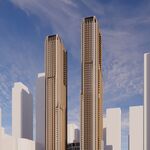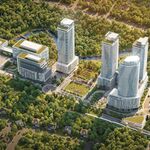B
boiler2000
Guest
Urban planning
The new New York
Dec 13th 2006 | FLUSHING MEADOWS, QUEENS
From The Economist print edition
Michael Bloomberg sets out a bold new vision for his city
Corbis
IN ITS early days New York was a city that looked forward. Its street grid was designed for 1m people at a time when the population barely topped 100,000. Central Park was planned 150 years ago in a swamp nowhere near the heart of Manhattan, which was then still downtown. The subway was built 100 years ago when much of New York was still farmland. But the city lost the vision thing about 50 years ago, as it slipped into what appeared to be an inexorable process of decline.
The best evidence of how much things have improved in New York is the fact that its mayor is again thinking visionary thoughts about the future. Although the city's fortunes started to recover under the strict hand of Mayor Rudy Giuliani in the 1990s, as recently as five years ago—when the terrorists attacked—it was easy to fear the worst for New York. But this week Michael Bloomberg, who succeeded Mr Giuliani soon after those attacks, unveiled a 25-year plan for upgrading the city. If it is implemented, it may have a bigger impact than the city's two greatest builders: Fiorello LaGuardia, mayor in the 1930s and 1940s, who oversaw massive public works programmes and built airports, and Robert Moses, who dominated urban planning in the middle of the 20th century, building roads, bridges and tunnels.
To Mr Bloomberg, New York is competing—especially with London—to be one of the great cities of the 21st century, attracting the increasingly mobile and wealthy global elite. His plan addresses what he sees as the three chief challenges facing the city as it makes that transition. First, he expects New York's population, already at a record high, to grow by around 1m by 2030, to 9m. Second, the city's infrastructure—much of it a century old—is crumbling, and needs to be upgraded. Third, the city must become much greener.
To transform New York into a “sustainable city†Mr Bloomberg has set ten goals, to be monitored by a new Sustainability Advisory Board made up of scientists, scholars, academics, city planners and environmentalists. The goals include a massive increase in affordable housing; the pledge that every New Yorker will live within ten minutes' walk of a public park; and an overhaul of public transport, including a subway extension. Mr Bloomberg wants New York to have the cleanest air of any big city in America and to reduce emissions that contribute to global warming by 30% by 2030. And he wants to open 90% of the surrounding rivers, harbours and bays for recreation by reducing water pollution and preserving natural spaces.
Wisely, Mr Bloomberg left the details of how to implement his vision to another day—probably in March. It will not be cheap, and cash will have to be found from somewhere. The influence over federal money enjoyed by Senator Chuck Schumer and Representative Charlie Rangel, now that the Democrats rule Congress, will help. So too might a more constructive relationship with the state, if the new governor, Eliot Spitzer, can bring Albany to heel as effectively as he did Wall Street. Happily, the city's bond rating is as good as it has ever been, and the financial alchemists in City Hall last week raised $2 billion to fund a West Side subway extension: a feat that may portend other creative money-raising.
The plan builds on work that Mayor Bloomberg has already put in train. Much of the city has been re-zoned to allow a better mix of offices (again in short supply), industrial activities and housing. Some $4 billion has been committed to finishing a third tunnel to bring water into the city, $1.6 billion to build a badly needed water-filtration plant and $13 billion for the most ambitious school-building upgrade ever. A former landfill, once the world's largest, will soon be the biggest new park to open in a century.
Upgrading the city's power supply, and making it far greener, seems certain to be one crucial battleground. Another hugely controversial issue will be whether, and how, to introduce congestion pricing for vehicles, probably at first in the bottom half of Manhattan. Mr Bloomberg is known to admire London's congestion charge. Having seen off smoking in the city's bars, he ought to be ready for what is perhaps an even greater political challenge. For the moment, he is still hesitating.
In general, though, he is a mayor in a hurry—and not just because, as rumour has it, he is considering a run for the presidency. His goal is to make the implementation of his vision for the city as irreversible as possible; for it is more than likely, after he steps down in 2009, that politics in New York will return to their bad, old, shortsighted ways.
The new New York
Dec 13th 2006 | FLUSHING MEADOWS, QUEENS
From The Economist print edition
Michael Bloomberg sets out a bold new vision for his city
Corbis
IN ITS early days New York was a city that looked forward. Its street grid was designed for 1m people at a time when the population barely topped 100,000. Central Park was planned 150 years ago in a swamp nowhere near the heart of Manhattan, which was then still downtown. The subway was built 100 years ago when much of New York was still farmland. But the city lost the vision thing about 50 years ago, as it slipped into what appeared to be an inexorable process of decline.
The best evidence of how much things have improved in New York is the fact that its mayor is again thinking visionary thoughts about the future. Although the city's fortunes started to recover under the strict hand of Mayor Rudy Giuliani in the 1990s, as recently as five years ago—when the terrorists attacked—it was easy to fear the worst for New York. But this week Michael Bloomberg, who succeeded Mr Giuliani soon after those attacks, unveiled a 25-year plan for upgrading the city. If it is implemented, it may have a bigger impact than the city's two greatest builders: Fiorello LaGuardia, mayor in the 1930s and 1940s, who oversaw massive public works programmes and built airports, and Robert Moses, who dominated urban planning in the middle of the 20th century, building roads, bridges and tunnels.
To Mr Bloomberg, New York is competing—especially with London—to be one of the great cities of the 21st century, attracting the increasingly mobile and wealthy global elite. His plan addresses what he sees as the three chief challenges facing the city as it makes that transition. First, he expects New York's population, already at a record high, to grow by around 1m by 2030, to 9m. Second, the city's infrastructure—much of it a century old—is crumbling, and needs to be upgraded. Third, the city must become much greener.
To transform New York into a “sustainable city†Mr Bloomberg has set ten goals, to be monitored by a new Sustainability Advisory Board made up of scientists, scholars, academics, city planners and environmentalists. The goals include a massive increase in affordable housing; the pledge that every New Yorker will live within ten minutes' walk of a public park; and an overhaul of public transport, including a subway extension. Mr Bloomberg wants New York to have the cleanest air of any big city in America and to reduce emissions that contribute to global warming by 30% by 2030. And he wants to open 90% of the surrounding rivers, harbours and bays for recreation by reducing water pollution and preserving natural spaces.
Wisely, Mr Bloomberg left the details of how to implement his vision to another day—probably in March. It will not be cheap, and cash will have to be found from somewhere. The influence over federal money enjoyed by Senator Chuck Schumer and Representative Charlie Rangel, now that the Democrats rule Congress, will help. So too might a more constructive relationship with the state, if the new governor, Eliot Spitzer, can bring Albany to heel as effectively as he did Wall Street. Happily, the city's bond rating is as good as it has ever been, and the financial alchemists in City Hall last week raised $2 billion to fund a West Side subway extension: a feat that may portend other creative money-raising.
The plan builds on work that Mayor Bloomberg has already put in train. Much of the city has been re-zoned to allow a better mix of offices (again in short supply), industrial activities and housing. Some $4 billion has been committed to finishing a third tunnel to bring water into the city, $1.6 billion to build a badly needed water-filtration plant and $13 billion for the most ambitious school-building upgrade ever. A former landfill, once the world's largest, will soon be the biggest new park to open in a century.
Upgrading the city's power supply, and making it far greener, seems certain to be one crucial battleground. Another hugely controversial issue will be whether, and how, to introduce congestion pricing for vehicles, probably at first in the bottom half of Manhattan. Mr Bloomberg is known to admire London's congestion charge. Having seen off smoking in the city's bars, he ought to be ready for what is perhaps an even greater political challenge. For the moment, he is still hesitating.
In general, though, he is a mayor in a hurry—and not just because, as rumour has it, he is considering a run for the presidency. His goal is to make the implementation of his vision for the city as irreversible as possible; for it is more than likely, after he steps down in 2009, that politics in New York will return to their bad, old, shortsighted ways.




